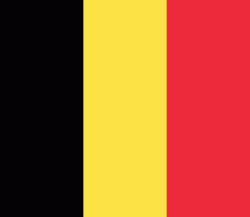Flag of Belgium
The national flag of Belgium (vlag van België, drapeau de la Belgique, Flagge Belgiens) is a tricolour consisting of three equal vertical bands displaying the national colours of Belgium: black, yellow, and red. The colours were taken from the coat of arms of the Duchy of Brabant, and the vertical design may be based on the flag of France. When flown, the black band is nearest the pole (at the hoist side). It has the unusual proportions of 1315.
In 1830, the flag, at that time non-officially, consisted of three horizontal bands, with the colors red, yellow and black. On 23 January 1831, the National Congress enshrined the tricolor in the Constitution, but did not determine the direction and order of the color bands. As a result, the "official" flag was given vertical stripes with the colors black, yellow and red.
After the death of Charlemagne, the present-day territory of Belgium (except the County of Flanders) became part of Lotharingia, which had a flag of two horizontal red stripes separated by a white stripe. The territory then passed into Spanish hands, and after the coronation of Charles V, Holy Roman Emperor, yellow and red, the colours of Spain, were added. From the 16th century to the end of the 18th century, the colours of what is now Belgium were red, white and yellow. Occasionally, the red Cross of Burgundy was placed on the white section of the flag.
During the period of Austrian rule, a number of different flags were tried. Eventually, the Austrian emperor imposed the Austrian flag. The population of Brussels was opposed to this, and, following the example of France, red, yellow and black cockades began to appear, those being the colours of Brabant. The colours thus correspond to the red lion of Hainaut, Limburg and Luxembourg, the yellow lion of Brabant, and the black lion of Flanders and Namur.
In 1830, the flag, at that time non-officially, consisted of three horizontal bands, with the colors red, yellow and black. On 23 January 1831, the National Congress enshrined the tricolor in the Constitution, but did not determine the direction and order of the color bands. As a result, the "official" flag was given vertical stripes with the colors black, yellow and red.
After the death of Charlemagne, the present-day territory of Belgium (except the County of Flanders) became part of Lotharingia, which had a flag of two horizontal red stripes separated by a white stripe. The territory then passed into Spanish hands, and after the coronation of Charles V, Holy Roman Emperor, yellow and red, the colours of Spain, were added. From the 16th century to the end of the 18th century, the colours of what is now Belgium were red, white and yellow. Occasionally, the red Cross of Burgundy was placed on the white section of the flag.
During the period of Austrian rule, a number of different flags were tried. Eventually, the Austrian emperor imposed the Austrian flag. The population of Brussels was opposed to this, and, following the example of France, red, yellow and black cockades began to appear, those being the colours of Brabant. The colours thus correspond to the red lion of Hainaut, Limburg and Luxembourg, the yellow lion of Brabant, and the black lion of Flanders and Namur.
National flag
Country - Belgium
Warning: getimagesize(/Image/Map/MP2802361.gif): failed to open stream: No such file or directory in /home/mapnlee7/public_html/MAPNALL/article.php on line 532
 |
 |
Belgium is a sovereign state and a federal constitutional monarchy with a parliamentary system. Its institutional organization is complex and is structured on both regional and linguistic grounds. It is divided into three highly autonomous regions: the Flemish Region (Flanders) in the north, the Walloon Region (Wallonia) in the south, and the Brussels-Capital Region. Brussels is the smallest and most densely populated region, as well as the richest region in terms of GDP per capita. Belgium is also home to two main linguistic communities: the Flemish Community, which constitutes about 60 percent of the population, and the French Community, which constitutes about 40 percent of the population. A small German-speaking Community, numbering around one percent, exists in the East Cantons. The Brussels-Capital Region is officially bilingual in French and Dutch, although French is the dominant language.
